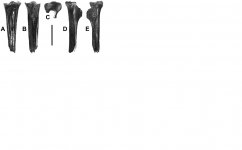Melanie
Well-known member

Systematics and distribution of the living and fossil small barn owls of the West Indies (Aves: Strigiformes: Tytonidae)
WILLIAM SUÁREZ, STORRS L. OLSON
Abstract
After reviewing the systematics and distribution of the living and fossil small West Indian taxa of Tytonidae (Tyto), we reached the following conclusions: (1) Strix tuidara J. E. Gray, 1827, type locality of Brazil, is the earliest available and correct name to be used in a binomen for New World mainland barn owls; (2) the North American mainland subspecies Tyto tuidara pratincola (Bonaparte, 1838), new combination, is resident in the Bahamas (“Tyto perlatus lucayanus” Riley, 1913, is a synonym), where it probably did not colonize until after the European introduction of Rattus Fischer, in Hispaniola (Dominican Republic and Haiti) where it became established in the 20th century, and subsequently in Puerto Rico; (3) Tyto furcata (Temminck, 1827) of Cuba, Jamaica and the Cayman Islands is a different species restricted to its insular distribution, with “T. alba niveicauda” Parkes & Phillips, 1978, of the Isle of Pines (now Isla de la Juventud) as a synonym; (4) the distinct species Tyto glaucops (Kaup, 1852), now endemic to Hispaniola, once occurred in Puerto Rico, as the fossil species “T. cavatica” Wetmore, 1920, is here shown to be a synonym; (5) the smallest taxon Tyto insularis (Pelzeln, 1872) of the southern Lesser Antilles is treated as a separate species, in which the nominate subspecies T. i. insularis (St. Vincent, Grenada, and the Grenadines) differs slightly but consistently in coloration from T. i. nigrescens (Lawrence, 1878) of Dominica; (6) another barn owl, Tyto maniola, new species, of this group of small tytonids from the West Indies inhabited Cuba during part of the Quaternary, and is here named and described.
Keywords
Aves, Tytonidae, Distribution, Fossil Birds, Systematics, Tyto, West Indies
www.biotaxa.org/Zootaxa/article/view/zootaxa.4830.3.4
WILLIAM SUÁREZ, STORRS L. OLSON
Abstract
After reviewing the systematics and distribution of the living and fossil small West Indian taxa of Tytonidae (Tyto), we reached the following conclusions: (1) Strix tuidara J. E. Gray, 1827, type locality of Brazil, is the earliest available and correct name to be used in a binomen for New World mainland barn owls; (2) the North American mainland subspecies Tyto tuidara pratincola (Bonaparte, 1838), new combination, is resident in the Bahamas (“Tyto perlatus lucayanus” Riley, 1913, is a synonym), where it probably did not colonize until after the European introduction of Rattus Fischer, in Hispaniola (Dominican Republic and Haiti) where it became established in the 20th century, and subsequently in Puerto Rico; (3) Tyto furcata (Temminck, 1827) of Cuba, Jamaica and the Cayman Islands is a different species restricted to its insular distribution, with “T. alba niveicauda” Parkes & Phillips, 1978, of the Isle of Pines (now Isla de la Juventud) as a synonym; (4) the distinct species Tyto glaucops (Kaup, 1852), now endemic to Hispaniola, once occurred in Puerto Rico, as the fossil species “T. cavatica” Wetmore, 1920, is here shown to be a synonym; (5) the smallest taxon Tyto insularis (Pelzeln, 1872) of the southern Lesser Antilles is treated as a separate species, in which the nominate subspecies T. i. insularis (St. Vincent, Grenada, and the Grenadines) differs slightly but consistently in coloration from T. i. nigrescens (Lawrence, 1878) of Dominica; (6) another barn owl, Tyto maniola, new species, of this group of small tytonids from the West Indies inhabited Cuba during part of the Quaternary, and is here named and described.
Keywords
Aves, Tytonidae, Distribution, Fossil Birds, Systematics, Tyto, West Indies
www.biotaxa.org/Zootaxa/article/view/zootaxa.4830.3.4





